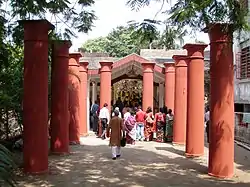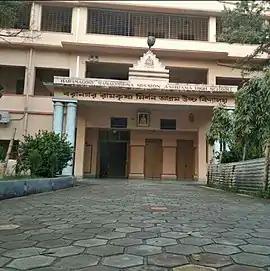Sabarna Roy Choudhury
The Sabarna Ray Chaudhury (Bengali: সাবর্ণ রায় চৌধুরী) family were Zamindars near the Kolkata (earlier known as Calcutta) area, prior to the arrival of the British.

Family history
One of the ancestors of the family, Panchanan Gangopadhyay left Amati to settle in Gohatta-Gopalpur, Hooghly district.[1] This Panchanan Gangopadhyay (Panchu Saktikhan) acquired the Khan title from the Mughal Emperor Humayun in the sixteenth century, for his bravery as a cavalry officer in charge of Pathan soldiers. Around the middle of that century he constructed a palace at a place which came to be known as Haveli Sahar or Halisahar. It was from Halisahar that the family spread far and wide, including, to Uttarpara, Birati, Barisha and Kheput.[2][3]
The British
The three villages of Sutanuti, Govindapur and Kalikata were part of a khas mahal or imperial jagir or an estate belonging to the Mughal emperor himself, whose jagirdari rights were held by the Sabarna Roy Choudhury family. The British settlement was surrounded by thirty-eight villages held by others. Although in 1717, the British East India Company was permitted by the Mughal emperor Farrukhsiyar to rent or acquire zamindari rights in them, it was unable to procure the land from the zamindars or local landlords.[4]
Even the Sabarna Roy Choudhury family was not keen to allow the British to settle or do trading on these villages, but the British had paid a bribe at the Mughal Durbar to ensure that the deal did not fail.[5] Just prior to their move to Barisha, the Roy Choudhury family had to transfer their rights over Kalikata in 1698, to the East India Company much against their wishes and protests.[3]
Public interest litigation
The 'Sabarna Roy Choudhury Paribar Parishad' and nine eminent intellectuals of the city filed a public interest litigation before the Kolkata High Court in 2001. The Court, upon an Expert Committee finding, declared on 16 May 2003, that Job Charnock cannot be regarded as the founder of the city and 24th August also cannot be considered as the city's birthday.[6][7]
See also
References
- Roy Choudhuri, Bhabani (2006). Bangiya Sabarna Katha, Kalikshetra Kalikata (in Bengali). Calcutta: Manna Publication. p. 17 & 18.
- Patree, Purnendu, Purano Kolkatar Kathachitra, (in Bengali), pp. 154-5, 3rd edition, 1995, Dey’s Publishing, ISBN 81-7079-751-9
- Roy, Samaren, Calcutta: Society and Change 1690-1990, p 8, 2005, iUniverse, ISBN 0-595-34230-2, from google books
- Nair, P. Thankappan, The Growth and Development of Old Calcutta, in Calcutta, the Living City, Vol I, p. 11, edited by Sukanta Chaudhuri, Oxford University Press, ISBN 0-19-563696-1
- Bandopadhyay Debashis, Purano Kolkatar gharbari, (in Bengali), pp. 1-2, second impression, 2002, Ananda Publishers Private Limited, ISBN 81-7756-158-8
- Gupta, Subhrangshu (17 May 2003). "Job Charnock not Kolkata founder: HC Says city has no foundation day". The Tribune online edition. Retrieved 30 June 2008.
- http://news.bbc.co.uk/2/hi/south_asia/3034419.stm
